This article should be read as the continuation of a series I wrote for Jadaliyya on art and the Egyptian revolution, the most recent of which was posted on 25 January 2013 and entitled “The Dramaturgy of a Street Corner”. For the past three years, graffiti in Egypt has drawn a record level of attention from the international media. If one performs a Google search using the keywords “graffiti Egypt”, about 10,900,000 results appear. If one searches for the same keywords on youtube, there are 396,000 results. The immediate impression one gets, not only from the Internet, but also when following the cultural scene in Cairo, is that since January 2011 nothing has become more popular and fashionable amongst foreign and Egyptian journalists and film makers than producing youtube videos, articles for both Arabic newspapers and the international press, as well as reports and documentaries about Egyptian street art and graffiti. Several publications on graffiti are already out. Graffiti of Egyptian Revolution by Maliha Maslamani (2013), Gowaya Shahid [“Inside Me Is A Martyr”] by Heba Helmi (2013), Revolution Graffiti: Street Art of the New Egypt by Mia Gröndhal (2013), and Wall Talk: Graffiti of the Egyptian Revolution, (2012) are the most recent publications to be added to a long list of forthcoming books.
It is possible to argue that we are witnessing a moment in the making of a new visual culture that is itself reshaping the public culture and art scene of the city. The offline world has been interacting with the world of the online, which has been given a free hand through the growing significance of the Youtube postings of photography and documentary films that are then screened or exhibited in public spaces. Youtube, facebook and twitter posting has allowed large audiences to follow the events in Tahrir Square, and the confrontations and urban wars throughout the country, by the minute.
This is in turn transforming the visual landscape and people’s behavior in public spaces. W.J.T Mitchell (2012: 9) draws a common denominator among all the “occupation” movements as reproducing an “anti-iconic, non-sovereign image repertoire”. I would like to argue that one of the main material transformations of the city of Cairo since January 2011 has been precisely over the fascinating art and tactics of squatting in public spaces, in what Mitchell (2012: 11) calls “the rhetoric of space”. Visual arts, plastic arts, cinema, photography, cartoons, graffiti, music, public installations, choreography and dance have witnessed an incredible creative moment as never before in past decades. Fantastic photography exhibitions multiplied all over the city. Excellent photo reportages by Egyptians have taken the lead, often costing lives and traumatizing experiences. Daily encounters with violent armed ‘thugs’ and lethal teargas has taught reporters as well as pedestrians new ways of moving and protecting themselves in the streets. Evidently, the magical effect of occupying Tahrir Square created a new public insurgent performative culture that will require many more years of analysis and reflection.
In this context, the significance of Mohamed Mahmoud Street – as a space that witnessed violent confrontations for three consecutive years of revolution – deserves more, and more nuanced, attention. Graffiti is only one part of the story of this street: it also plays host to numerous, meaningful interactions every day. So many of these details go unnoticed: the placing, displacing and replacing of icons, the building of concrete blocks which are then torn down, the appearance of material things such as framed photographs of martyrs below the walls, followed by their disappearance. The wilting flowers, the creation of a space for planting trees below the walls that are then intentionally destroyed. The entire families with children, the Islamists, the Salafis, and the passersby who have posed with banners and placards at various times before the street’s painted walls. The burning of the Lycée School in November 2012. Media and sports celebrity-spotting when visiting the street, and contemplating them being filmed by large television crews, surrounded by bewildered street children and local customers.
The spontaneous cafés appearing and disappearing, the street children camped on the pavements, and the diplomats arriving in official cars, their bodyguards protecting them while they take pictures of the wall. The multiple gatherings that took place over the past three years, such as the Ultras Ahlawy fans singing and drumming during their 2012 demonstrations. Or the stories of ‘Amm Sayyid, the newspaper seller opposite the entrance gate of the American University in Cairo (AUC), who has been caught in the turmoil of its urban battles, and beaten up by thugs attacking the protesters of Tahrir Square. Or the carpark attendant of nearby Yusuf al-Gindi Street who informs me regularly of every single new work of graffiti that appears, and on which particular wall.
Then there are the young female students of the Lycée on Yusuf al-Gindi Street, who protested in 2012, after a concrete wall constructed by the army hindered them from reaching their school’s entrance. The resulting long detour via the parallel streets meant daily sexual harassment from the soldiers outside the Ministry of Interior, and made them organize a public protest in the street. What was fascinating then was the female students’ refusal to negotiate with the school’s principal, unless he met them on the street. Their strategy was to make their protest a public issue. I witnessed the first hour of heated confrontations with the principal myself. The girls were screaming at him, outraged. He tried hopelessly to convince them to go to school, but failed. They succeeded in getting the wall moved back by a few meters, so that the school entrance could be reached from Mohamed Mahmoud Street.
All this tells us a great deal about the highly charged human interactions hosted in Mohamed Mahmoud Street. Also known as “The Eyes of Freedom Street”, or “The Street of the Martyrs”, it continues to be highly significant, not only as a memorial space, but equally as an arena of public performance. The story in the following photographs is one more illustration.
Travelling Plaques
Here is an excerpted passage I wrote in late 2012: “On 7 December, I met a man at the corner of the street who had used tiles and sand to create a protected space for plants in front of the Mohamed Mahmoud Street wall. Insisting on his anonymity, and identifying himself as a “simple citizen of Egypt,” he told me that he was trying to create “a memorial space” for the martyrs of Mohamed Mahmoud Street’s battles by placing commemorative plants and icons in that area on a daily basis.
Together with a group of people, he decided to hang three plaques of black marble on the wall. The small plaque beneath the plants read: “From the people of Egypt”. Above the part-Mubarak-part-Tantawi-part-Badie portraits, another black stone displayed a Quranic verse. A third black plaque was nailed to the other side of the wall. Dedicated to the martyrs of the January 25 Revolution, it contained a poem by the late Amal Dunqul. The poem describes harsh walls that block the path of daylight, but paradoxically inspire hope in their eventual collapse.
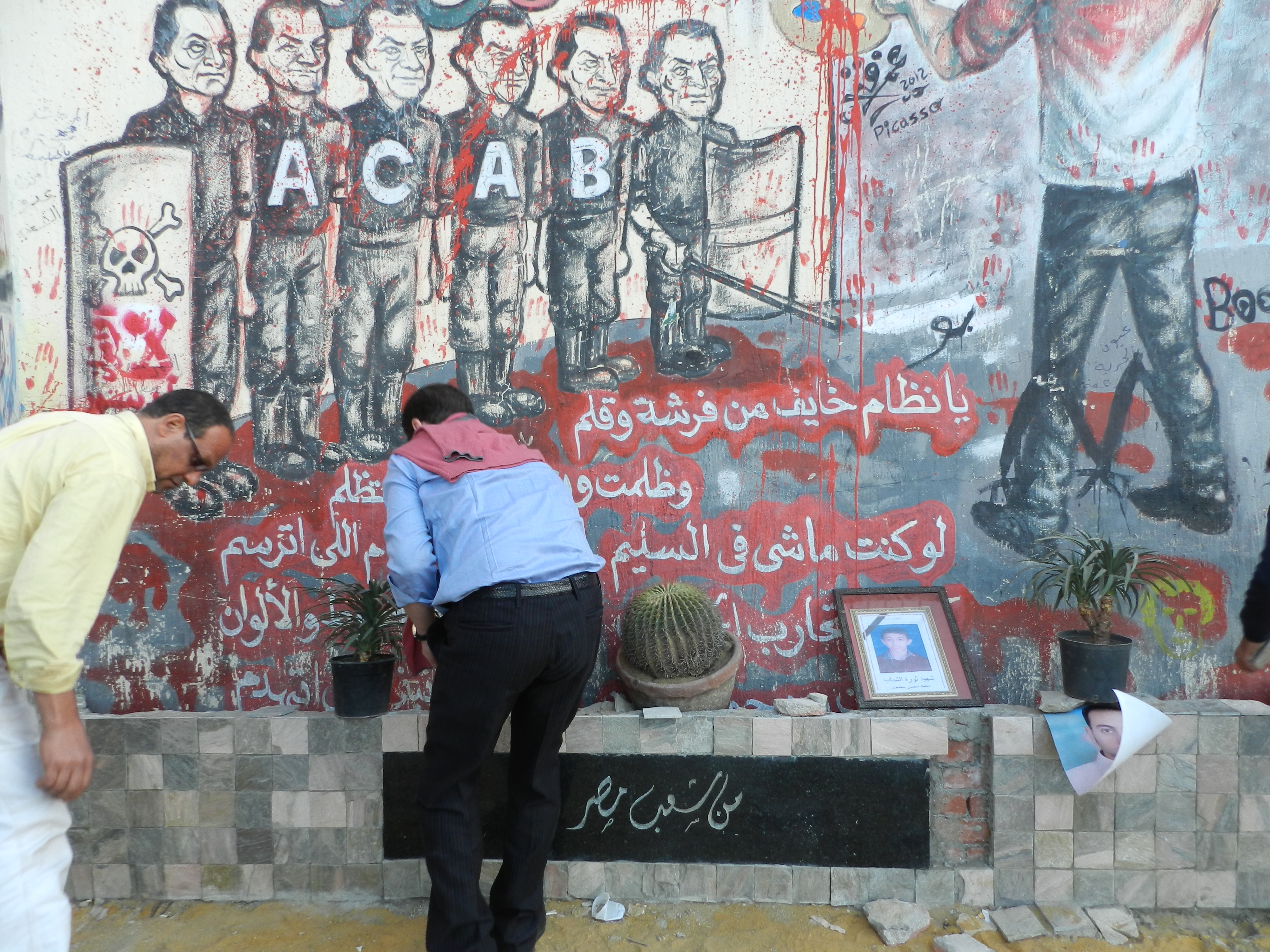
[Captured on 7 December 2012]

[Captured on 13 May 2013]
.jpg)
[Captured on 7 December 2012]
During 2012 and 2013, the corner was repeatedly whitewashed, and the graffiti endlessly redrawn. Graffiti mirrored the volatility and unprecedented pace of political events, and kept on constantly changing throughout 2013. At a certain point that year, the two plaques were painted, or rather whitewashed, like the rest of the wall, clearly with the intention of obscuring the writing they featured. Immediately, graffiti artists repainted the wall.
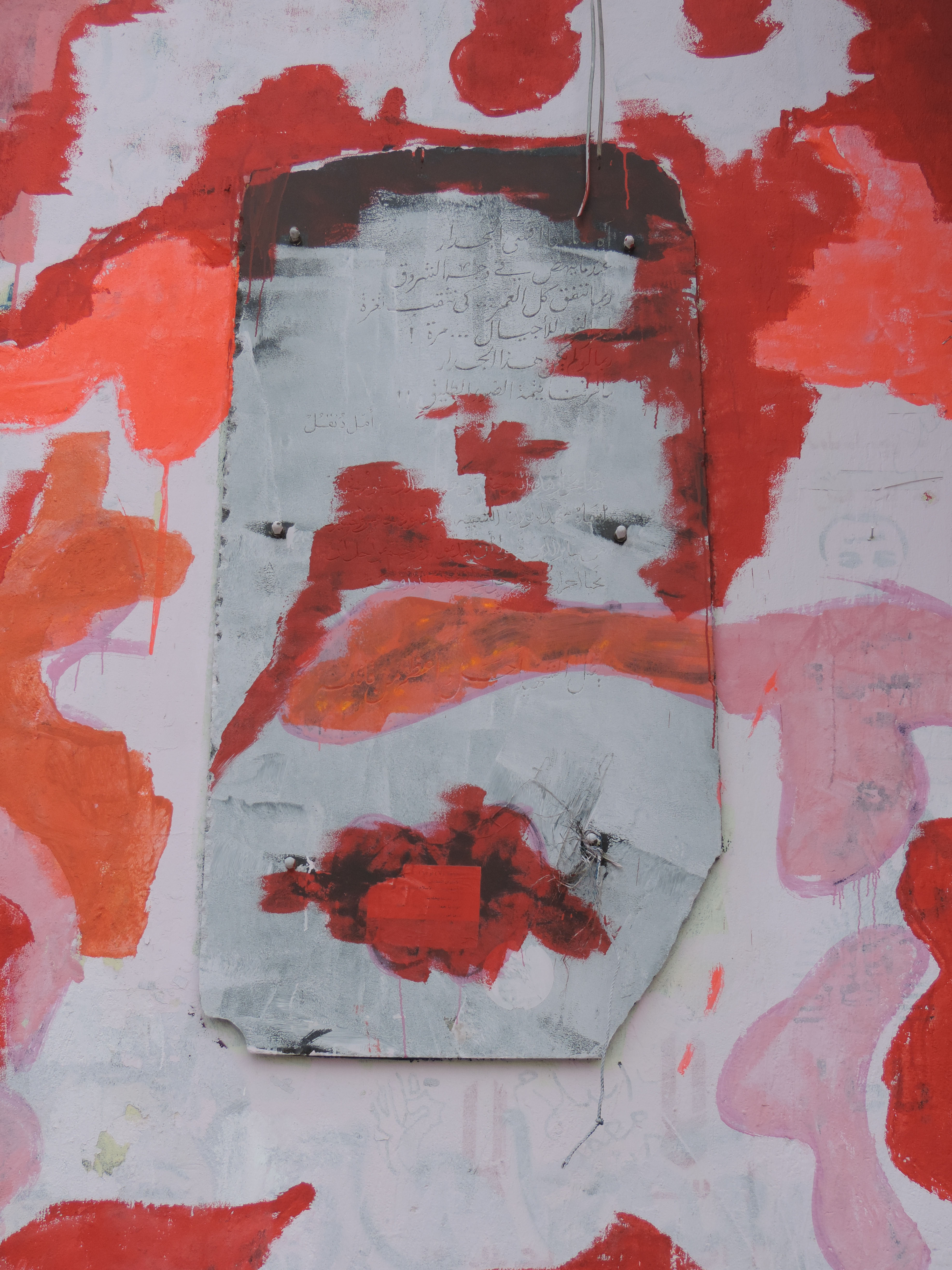
[Captured on 2 December 2012]
Until 14 March 2014, the small black plaque marked “For the people of Egypt” remained at the bottom of the wall, at the corner of Mohamed Mahmoud Street and Tahrir Square. Meanwhile, the graffiti on the corner kept on changing, as it had done for the previous three years.
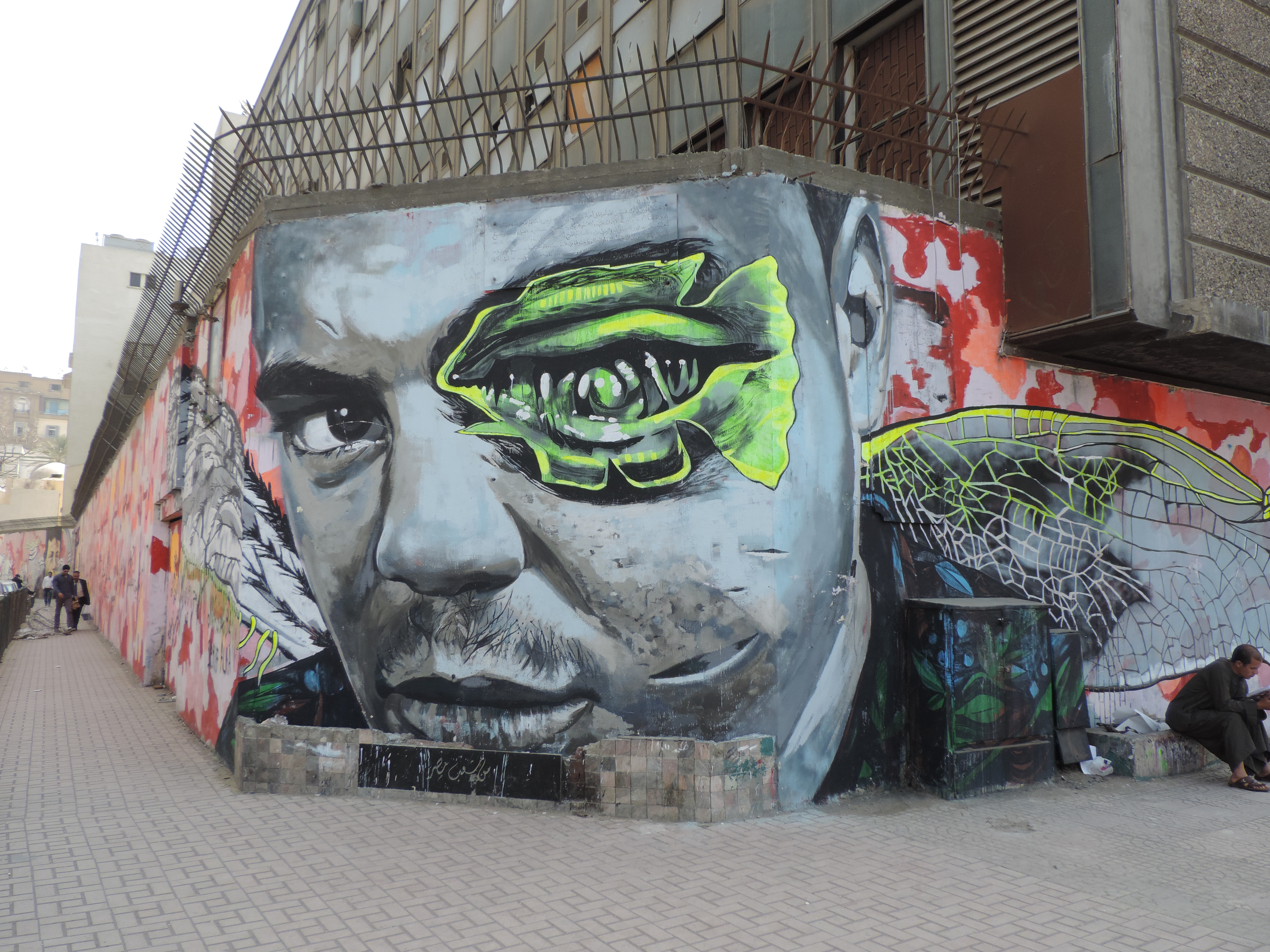
.jpg)
During November 2013 for example, the entire wall of the AUC’s Tahrir Campus was repainted in bright red and pink colors, with patterns resembling army uniform. This was a criticism of the military’s involvement in the August 2013 massacre against Muslim Brotherhood supporters in Raba’a al-‘Adawiyya Square. Near the entrance of the AUC, graffiti artist Ganzeer had painted a heap of skulls. On top of these stood a grim-faced military man.
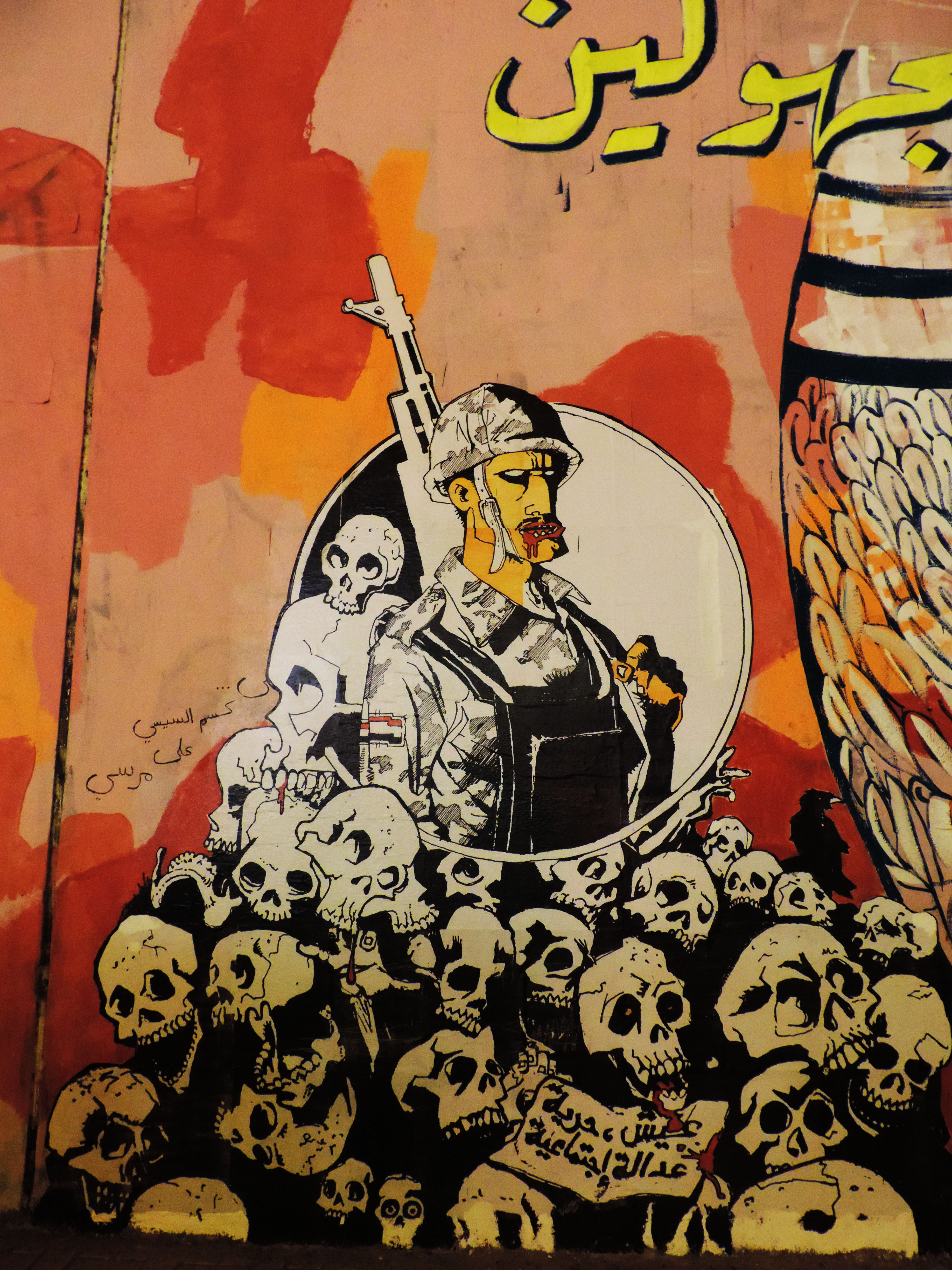
Police soldiers carrying guns also appeared on the wall. Another drawing depicted the military as apes. Irreverent insults multiplied against the army’s brutality – its killing, dragging, and denuding of Egyptian citizens. Just opposite the tanks, one could read on the bright red wall: “Kill, denude and jail”. The bright pink wall looked as surreal as it had done during November and December 2013 when the city was under curfew. Check points and barbed wire had been put up and army tanks appeared and reappeared in the center of town and in several other central points of the city, after the announcement of successive Friday demonstrations by the Muslim Brotherhood. Mohamed Mahmoud Street, like Tahrir Square, then underwent regular identity card control by army checkpoints.
Indeed after September 2013, officers and informants disguised as carpark attendants had reemerged all along Mohammed Mahmud Street. They threatened to incarcerate passersby if they took photographs, or if they came near the concrete buffer opposite the Ministry of Interior – this happened to me. Journalists and photographers were even jailed for taking photographs while covering the clashes after the ousting of Morsi. Still, in November and December 2013, these measures did not stop some passersby from posing for photographs with the soldiers in front of army tanks. It seemed to me a scene of déjà vu, a kind of collective repertoire. One way of reading this repertoire was as a longing for the eighteen magical days of January 2011, during which the army had refused to fire on protesters, and many took photographs with the soldiers afterwards.
But despite the new circumstances of late 2013, these young soldiers often looked exhausted from long hours spent standing on top of their tanks. Even more unusual was that some of these soldiers stationed at the entrance of Mohamed Mahmoud Street were college friends of the graffiti artists, and were quite sympathetic to their performative endeavors. One of the artists described how the soldiers would watch them when the artists brought ladders and painting materials, while fans would take photographs of the artists at work.
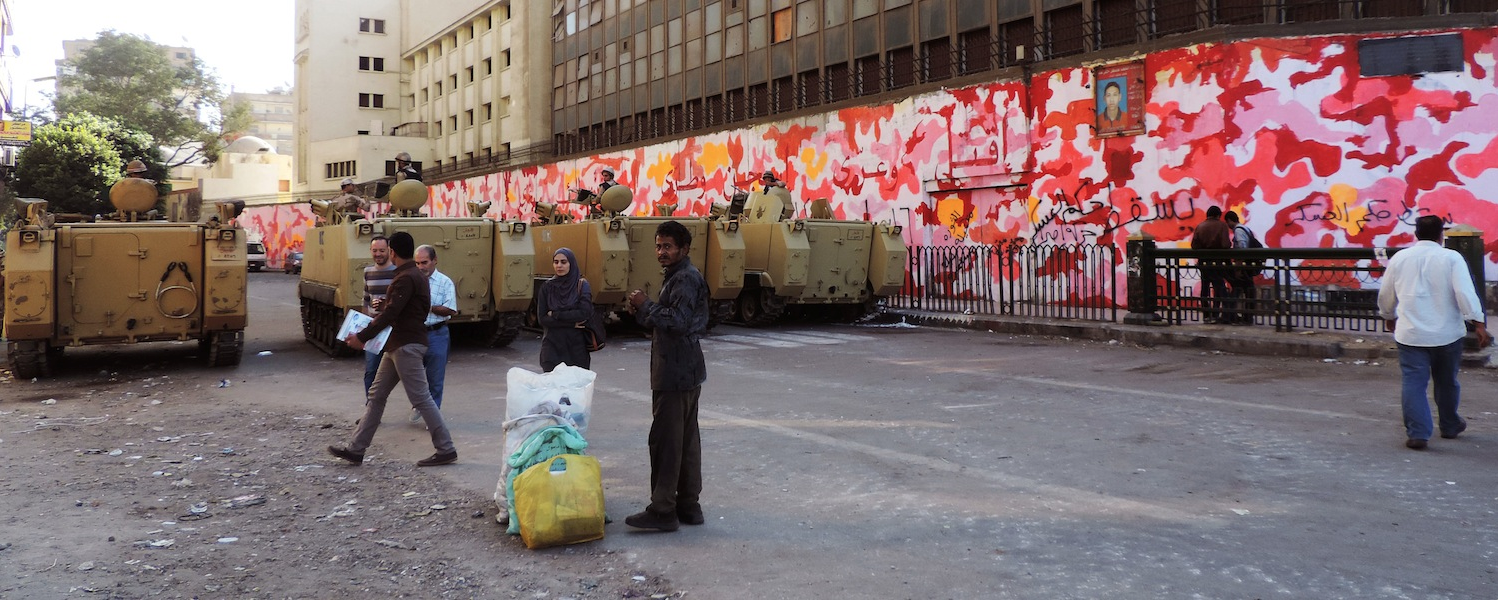
Three Plaques Become Four
By the end of March 2013, the three black plaques had been removed, to be hung this time in the middle of Mohamed Mahmoud Street’s wall, not far from the AUC entrance gate. The three plaques turned instead into four.
.jpg)
[Captured on 28 March 2014]

[Captured on 28 March 2014]

[Captured on 28 March 2014]

[Captured on 28 March 2014]
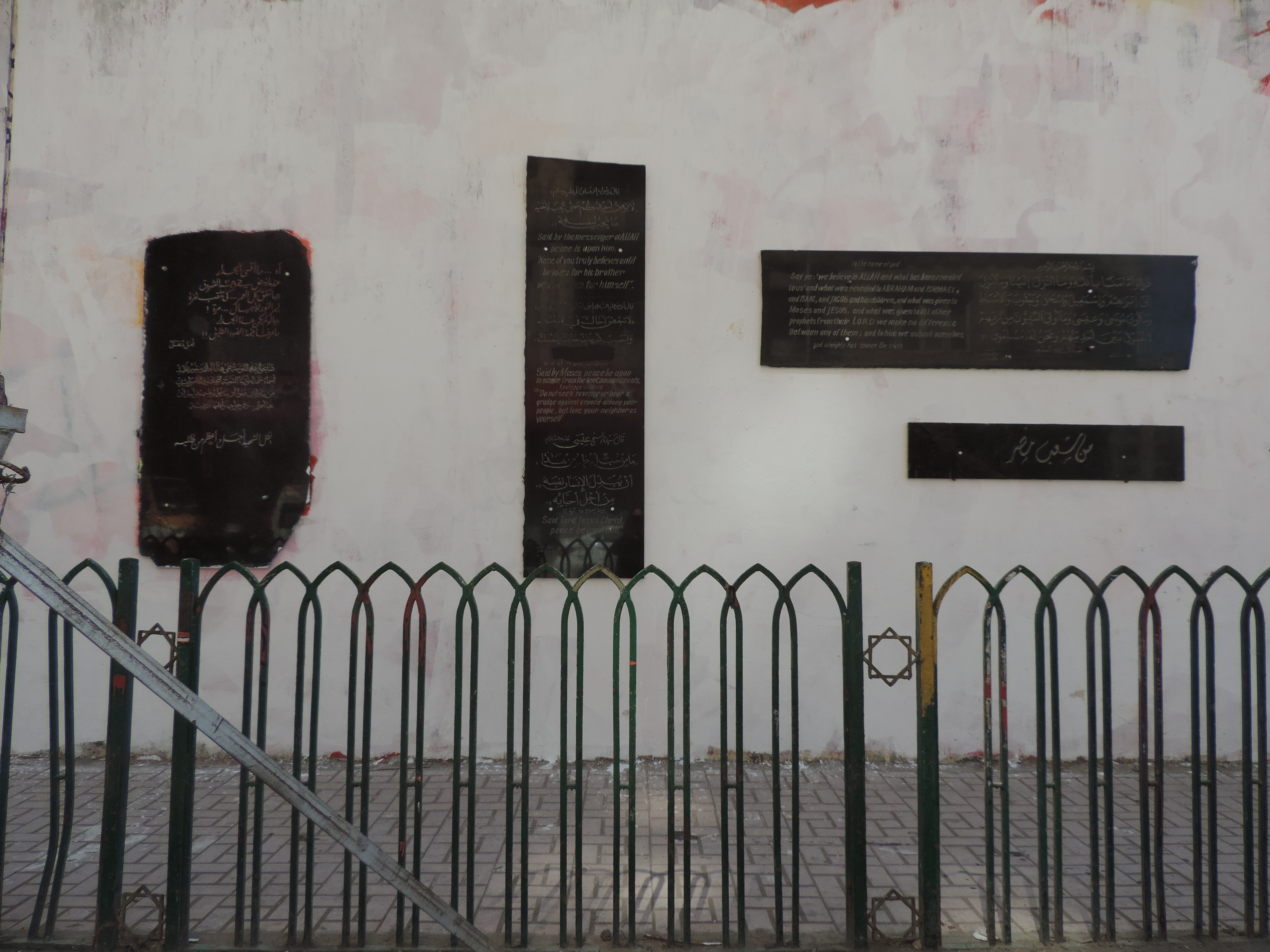
[Captured on 28 March 2014]
The small plaque, “For the People of Egypt”, was placed near the other plaque. On the right side, the plaque with the verses of Quran was placed of top of the small plaque with the words “For the people of Egypt”. Interestingly, the fourth, new plaque, was hung to the left of the old plaque, and juxtaposed Arabic and English language verses from the Quran with sayings from Moses and Jesus, which read as follows:
The Messenger of Allah, peace be upon him, said:
“None of you truly believes until he loves for his brother what he loves for himself”
And then in Arabic with a translation into English:
The prophet Moses, peace be upon him, said:
“Do not seek revenge or bear a grudge against anyone among your people, but love your neighbor as yourself” (Leviticus 19: 18)
There followed a similar Christian saying, on self-transformation out of love for others, followed by “Said Lord Jesus Christ, peace be upon him.”
The plaque featuring the Amal Dunqul poem in Arabic remained unchanged. Here is a tentative translation:
Oh, how harsh the walls can be
When rising before the sunrise
We might spend an entire life piercing them,
For light to go through to the generations… once!
Had it not been for this wall
We would not have known the value of free light!
The text underneath states: “Beneath this plaque, on this wall, we will memorialize the names of the martyrs of our glorious popular revolution of 25 January. Those who gave their lives so that we could live free… despite their wounds and buried pains.”
Then one more sentence reads as follows:
“The martyr will remain superior, and greater than his/her murderer.”
Not only are the travelling plaques striking, reminding us of the constantly multiplying numbers of martyrs, but they also symbolize the dynamic making of a collective memory. The display of English translations from the holy texts of the three monotheistic religions reveals an urgent desire to communicate universally about martyrdom, mourning, and perhaps about incomplete revolutions. Today, the pessimists argue that the martyrs, massacres and dramatic confrontations of the past three years have been forgotten, and that the deep state remains untouched. Yet as Mohamed Mahmoud Street’s stories show, Egypt has witnessed a palpable qualitative transformation in the public sphere and culture since 2011. It may be fragile, and hosts paradoxes and contradictions at times, but it continues its resistance.